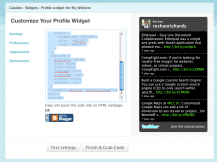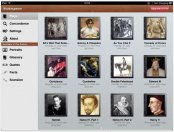The Vault: Posts through August 2015
SPAM Bots took over the comments! But I am unhiding these temporarily.
|
You can transport yourself back in time with Josten's Yearbook Yourself. It might be a stretch trying to find solid academic uses for this silly web app. However, I think that as students use more social media in school that have user profiles, the images generated in Yearbook Yourself might provide good in-between alternatives to using actual student photos and completely out-there avatars in those user profiles. From an administrative viewpoint, Josten's is a company that makes school yearbooks and they have been improving their web-based yearbook editing interface each year. They've now added a component for students to work together build custom pages and submit them to the master yearbook, without needing to be logged in. They're not cheap, but if your school is looking for forward thinking companies in the yearbook market, they are a good option.
0 Comments
There are some options for making collaborative concept maps. Webspiration is an online version of Inspiration (and Kidspiration). It's currently still in its public beta testing, but it looks like they are moving towards a subscription based model for their product. Most of the functionality of the full Inspiration software is available, and it is fairly easy to share, import, and export documents. An alternative to Webspiration might be to use the shared "Drawing" type of document available in Google Docs. It requires a little more manipulation to link shapes (ideas) to one another than Webspiration, but the canvas is really flexible and with a little time, users can get used to making the interface work for them.
A friend of mine shared with me last night a great free application for making concept maps (also commonly referred to as mind maps). MindNode is a simple and elegant tool with an easy to interface. Some might find that the inability to use shapes, images, arrows, and other design elements is a limitation, but I believe that it makes the presentation of the concept map ultimately more powerful. The drag and drop interface is extremely intuitive. Once you start a new node from the master, the color automatically changes according to a very . You can change the colors of the fonts of the text as well as the lines connecting items. My friend suggested that a fun activity to do in order to learn the interface would be to try and recreate the NYC Subway map.
Unfortunately, MindNode is only available for Macs, but they do have an iPhone/iTouch/iPad compatible app for $5.99. They also have a "pro" version that has some additional features that can be learned about here. I've been helping my wife (@LivingLuxe4Less) customize the look of her new blog, www.LivingLuxeForLess.com. Most free website and blog hosts (e.g. Blogger, WordPress, Weebly) have an option to edit the HTML code of a page or element. You don't need to be a web designer or programmer in order to use the HTML to make the page look exactly how you want. All you need to know is how to copy and paste.  For this site, which was created in Weebly, we added a couple of HTML elements: a Twitter status widget, an interactive image from Polyvore, and an email sign-up via Feedburner. First, we had to generate the code for the element in each respective site. We first went to Twitter's Goodies section, and followed their easy steps to generate the Twitter status widget. With a few easy clicks, a bunch of code was generated. We copied it, went to the Weebly interface and selected a "custom HTML" element. Here we were allowed to paste in the code, and as soon as we saved the element the widget automatically appeared. The code can look overwhelming but the truth is you don't really have to worry about what it means. Once you get the hang of embedding html into your website or blog, you'll start to notice that embed html options are available on a ton of websites and services. Etherpad was a simple and great web-based application that allowed multiple people to collaborate on a single document. Google acquired the company that developed it and released the code as open source. As a result, several replica sites of the original Etherpad have emerged. Google is supposed to be incorporating this technology into their Google Wave platform sometime soon. The interface is simple and elegant. A teacher or student needs to start the collaborative document space at site such as TypeWith.me or PiratePad.net. A link will be generated in the address bar and this URL can be emailed to the other collaborators. There is a space to enter the collaborators names, an option to assign a color to yourself to identify your contributions, and a space for live chat. It does not use user accounts, so co would have to export the document (or copy and paste the text) once the collaboration session has concluded.
It's basically a very stripped down shared Google document that is perfect for just-in-time collaboration. This tool might be great for a class to begin work on a collaborative note taking or document writing project that can then be later stored on Google docs (export or copy + paste). If you're looking for royalty-free images for websites, videos, or school projects, CompFight.com is a great tool that searches Flickr for photos that have been made available by the content creator via the Creative Commons license structure. This is a much better alternative to a Google Image Search, especially in schools. Alas Media shared this information at a workshop at BLC10. You can roll over the search results to see the image resolution. When you click on an image you'll be taken to Flickr's website where there is an option to view "all sizes" that are available for download. You will need a Flickr account (free) in order to download the photos.
You can use a Google custom search engine (CSE) to only search within specific websites. This might be especially helpful to educators who have a library of resources for a topic, curriculum unit, or even an entire school year. All you need is a Google account and then you can go to this page to get started. Once you've done the initial setup, you can add more sites to the search engine and add keywords to the search to help refine the results. I've been trying to learn more about how Google AdSense works. I set up a search page on this site that uses a custom search engine based on keywords. Apparently if people actually click on results from a search done there I will generate revenue. We'll see about that!
I can really see this being used by langauge, history, and social studies teachers who have tried to find dynamic ways to link and share the abundant resources available on the web to them. By using this tool you can teach students how to filter information while still guiding them towards quality materials. Customized Google Maps can add a lot of dimension to any lesson or project. Jim Wenzloff shared some powerful features of this free web-based application. All you need is a Google account, and when you log into Google Maps you'll see a tab for My Maps. You can pin locations, add descriptions and images, share maps, and overlay multiple custom maps. One cool feature that I didn't know about was the library of Google Map Gadgets where you can add other people's custom maps to your list of maps. You can use these custom maps like filters. Fun ones to try are 'Earth at Night' and 'Dig a Hole Through the Earth. If you click on the "More..." button, you can view content that is linked to photos, video, or Wikipedia entries. If you choose webcams, you can see up to the minute images taken from webcams all around the world.
Seth Bowers shared a bunch of great iPad resources for educators this past week. Here are a couple that have to do with English and literacy:  iWriteWords is a well designed app for early childhood students learning how to form letters and put the letters into words. There is a free "Lite" version as well as a paid version that has some additional features.  StoryKit is an interesting app that lets you rewrite the words to classic stories such as Three Little Pigs, Humpty Dumpty, and Three Bears. Users can also create their own story books by using pictures saved on the device or user generated drawings. Text can be typed on on each page along with sound effects or narration. This could be great for early elementary aged students  Shakespeare is a robust free app that has most (all?) of Shakespeare's plays available in an easy to navigate and read setup. Each play contains synopses , descriptions of characters, and the complete scenes. The Pro edition ($9.99) contains portraits, a glossary, famous quotes and facts, and the ability to mark the patterns of words (e.g. Iambic Pentameter) on the screen. I learned a great trick in iMovie for making digital photo and video stories with accompanying music. The folks at Alas Media showed how when you open a music track in iMovie and view the "clip trimmer", you can play the song and press the 'M' key to mark keyframes where the photo or video would change. This is much easier than trying to line up clips or photos with the audio wave form (as I used to do in Windows Movie Maker). The result is a movie that has similar effects to those autogenerated movies from Animoto. Alas Media does a really good job leading workshops about media production. They have a ton of resources and tips and tricks at www.alaslearns.com.
|
WatchFollowArchives
August 2015
Header photo by Robert S. Donovan
|